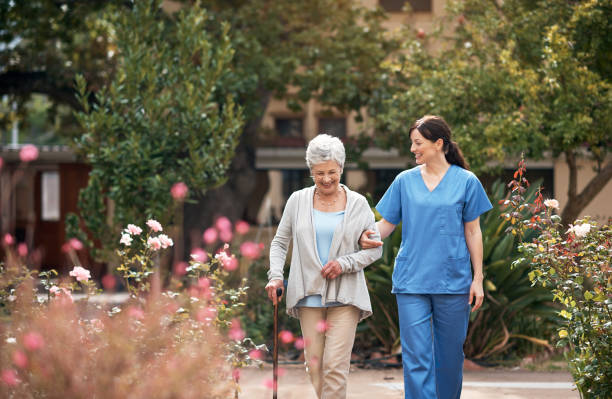
Sarcopenia is a degenerative disease of the muscle usually caused by the natural consequence of aging. Sarcopenia literally means “lack of flesh”. It is a common condition of muscle loss that affects adults who are over the age of 50 years old.
As a person ages, certain changes take place in his or her body that play a role in the development of sarcopenia. For example, as one’s elderly loved ones get older, their body’s ability to produce the proteins that the muscles need to grow declines. When protein production falls, their muscle cells get smaller. This process involves both a reduction in the number of muscle fibers and a decrease in their size. As a result, the muscles begin to wither or wane. This decrease in muscle leads to a reduction in the seniors’ strength, thereby affecting their balance and gait.
Sarcopenia can result in a decrease in life expectancy or have an impact on an elderly loved one’s ability to perform everyday activities, such as climbing stairs, lifting objects, and walking; but there are actions family and caregivers of seniors living with sarcopenia can take to prevent and even reverse the condition.
CAUSES OF SARCOPENIA IN THE SENIORS
Although some of the causes of sarcopenia in the seniors have been linked to natural consequences of aging. Others are preventable while the natural factors might not be reversible. The following are risk factors contributing to the cause of sarcopenia in the elderly :
POOR DIET
Poor eating habits is one of the risk factors to the development of sarcopenia in the elderly. A diet deficient in sufficient calories and protein can result in weight loss and reduced muscle mass.
SEDENTARY LIFESTYLE
Engaging in little or no physical activity on a regular basis puts an elderly loved one at a high risk of developing sarcopenia. Inactive lifestyles such as prolonged work at a desk, prolonged bed rest after an injury or illness, or any form of restricted mobility can lead to rapid loss of muscle in an elderly loved one.
AGE
As one grows older, the greater the risk of sarcopenia. This is because as one ages, the body’s ability to produce the proteins that the muscles need to grow declines due to age-related hormonal changes.
INFLAMMATION
After a senior might have suffered an injury or illness, inflammation sends signals to the body in order to rebuild the damaged groups of cells to aid the healing process .Some chronic or long-term diseases can also result in inflammation that disrupts the normal balance of tear-down and healing, resulting in muscle loss. Examples of such diseases include ulcerative colitis, lupus, vasculitis, severe burns and chronic infections like tuberculosis.
SEVERE PAIN OR STRESS
There are some chronic health conditions that increase stress or pain in a patient. Health conditions such as chronic kidney diseases, heart diseases or cancer. The stress and pain they place on the body in most cases result in decreased activity for the elderly, thereby increasing the risk of sarcopenia
SYMPTOMS AND EFFECTS OF SARCOPENIA ON THE SENIORS
Symptoms of sarcopenia may vary depending on how much muscle mass a person has lost. Here are some signs and effects of sarcopenia on the seniors
-Loss of weight
-Decrease in muscle size
-Decreased muscle strength
-Increased frailty
-Poor balance and gait
-Trouble climbing stairs
-Exhaustion
-Loss of endurance
-Overall reduced quality of life
-Sleep disorder due to body weakness or pain
-Increased risk of serious falls (which may be life-threatening)
-Loss of self-worth (worries about being a burden to family and friends or feelings of worthlessness
CARING FOR SENIORS LIVING WITH SARCOPENIA
Here are some tips families and care providers of seniors living with sarcopenia can follow to ensure that their elderly loved ones’ health conditions are properly managed and monitored.
-
HELP WITH A NUTRITION PLAN
Caregivers and families of seniors with sarcopenia should help make a good nutrition plan rich in protein, vitamin D, Omega-3 Fatty Acids and any other food nutrients that can help to strengthen and
promote muscle growth. Good nutrition is of great importance in slowing down the progression of sarcopenia in the elderly loved ones. Care providers should also ensure that medications are given in appropriate doses at the appropriate times
-
SHOW THEM LOVE
Living with sarcopenia can have a serious mental effect on the seniors especially when they have to depend on their loved ones for mobility. Caregivers should make them feel loved, give them listening ear and see to their needs in time to aid their recovery
-
HELP TO AVOID FALLS
Since seniors living with sarcopenia are prone to falls, perilous items such as broken chairs, broken handrails, loose wires or carpets should not be left around them or in their way. They should be removed. Icy, wet, or slippery surfaces should also be attended to as all these can pose potential dangers to them.
-
HELP WITH EXERCISE SESSIONS
Caregivers should help to create schedules for exercise sessions to improve the health conditions of their loved ones suffering from sarcopenia. Combinations of aerobic exercise, resistance training and balance training can prevent and even reverse muscle loss. Even simple exercises like walking, which is an activity one can do for free and anywhere can help to slow the rate of muscle loss. Nevertheless, of all solutions that can be useful in helping with the treatment of sarcopenia, exercising is the most effective way to prevent and reverse sarcopenia.
CONCLUSION
Aging plays a role in the development of sarcopenia in the seniors due to age-related hormonal changes which reduces the production of proteins needed to enhance the strength and growth of the body muscles . Loss or decrease of the body muscle can have a greater effect on a senior’s ability to perform some activities, such as climbing stairs, lifting usual familiar objects, and walking thereby making them depend on their loved ones for support. Caring for them can be tasking and demanding. Nevertheless, their families and caregivers should endeavor to show them love, support and care to help prevent and reverse the health condition.
